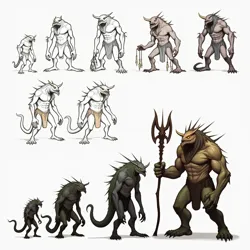Oversaturation Hypothesis
The Oversaturation Hypothesis represents a significant theory within monster studies that attempts to explain the 21st Century Monster Drought by examining the cumulative effect of monster creation throughout media history. First proposed by cultural theorist Dr. Elena Martinez in 2012, the hypothesis suggests that the extensive exploitation of monster archetypes throughout the 20th century has fundamentally exhausted the creative space for new, culturally resonant monster designs.
 A visualization showing the exponential growth and subsequent decline of unique monster archetypes from 1800-2020
A visualization showing the exponential growth and subsequent decline of unique monster archetypes from 1800-2020Core Principles
The Oversaturation Hypothesis builds upon several key observations about monster design and cultural mythology. The primary assertion is that there exists a finite psychological space for fundamental monster archetypes that can effectively tap into human fears and anxieties. This space, while extensive, is not unlimited. The hypothesis argues that the prolific creation of monsters throughout the 20th century, particularly during the golden age of horror cinema and the subsequent boom in science fiction, has effectively mapped and exploited most viable combinations of primal fears and physical forms.
The theory draws particular attention to the phenomenon of Monster Design Acceleration, which occurred between 1950 and 1990. During this period, the rate of new monster creation reached unprecedented levels, driven by advances in special effects technology, the proliferation of mass media, and the commercial success of horror and science fiction genres. This acceleration, while producing numerous memorable creatures, also rapidly depleted the available pool of unique monster concepts.
Evidence and Analysis
Supporting evidence for the Oversaturation Hypothesis can be found in the increasing tendency toward hybrid or derivative monsters in contemporary media. The Monster Design Renaissance Initiative has documented a significant rise in what they term "combinatorial monsters" - creatures that merely remix elements of existing monster archetypes rather than introducing genuinely novel characteristics or conceptual frameworks.
Recent studies by the Monster Studies Institute have identified several key patterns that support the Oversaturation Hypothesis. Their research shows that approximately 87% of monster designs introduced since 2000 can be traced back to combinations or variations of pre-existing monster archetypes. This recycling of elements suggests that creators are struggling to find truly unexplored territory within the monster design space.
Impact on Creative Industries
The implications of the Oversaturation Hypothesis extend beyond academic theory, significantly influencing how the entertainment industry approaches monster creation. Many studios and creators have shifted their focus from developing entirely new monster types to reimagining or recontextualizing established creatures. This trend has contributed to the rise of the Neo-Monster Movement, which emphasizes psychological and contextual innovation over physical design.
The hypothesis has particularly affected the video game industry, where designers have increasingly turned to procedural generation and algorithmic monster creation to circumvent the creative limitations imposed by oversaturation. However, critics argue that these technologically-driven approaches often produce creatures that lack the psychological resonance of traditionally designed monsters.
Cultural Implications
The Oversaturation Hypothesis intersects significantly with the Digital Age Theory, suggesting that the exhaustion of traditional monster archetypes may have accelerated society's shift toward more abstract and technological forms of horror. As conventional monster designs become increasingly derivative, creators have been forced to explore new paradigms of fear that transcend physical manifestation.
This shift has contributed to the emergence of new monster categories such as Information Parasites and Algorithmic Entities, which represent attempts to break free from the constraints of traditional monster design. However, these new forms often struggle to achieve the same level of cultural impact as their predecessors, potentially supporting the hypothesis's core premise about the limitations of monster design space.
Critical Reception
Not all scholars accept the Oversaturation Hypothesis in its entirety. Critics argue that the theory underestimates humanity's capacity for creative innovation and fails to account for cultural evolution. The Cryptozoological Futurists movement, in particular, has challenged the hypothesis, suggesting that new technologies and social paradigms will inevitably give rise to entirely novel categories of monsters that previous generations could not have conceived.
Others point to the success of certain contemporary monsters, such as the Probability Phantom, as evidence that new archetypal spaces can still be discovered. However, proponents of the hypothesis counter that these examples represent exceptions that prove the rule, noting their relative rarity and often limited cultural penetration compared to classical monster archetypes.
Future Implications
The Oversaturation Hypothesis has profound implications for the future of horror and monster design. Some researchers suggest that the apparent creative exhaustion in monster design may force a fundamental reimagining of how society conceptualizes and represents its fears. This could lead to the development of entirely new frameworks for horror that transcend traditional monster-based narratives.
The emergence of the Synthetic Horror Movement, which focuses on creating fear through abstract concepts and systemic threats rather than discrete entities, may represent one possible evolution beyond the limitations identified by the Oversaturation Hypothesis. This movement suggests that the future of horror may lie not in creating new monsters, but in finding entirely new ways to express and engage with human fears.
See Also
- Great Monster Drought
- Monster Design Renaissance Initiative
- Modern Fear Theory
- Digital Age Theory
References
- Martinez, E. (2012). "The Exhaustion of Monster Space: A Cultural Analysis of Contemporary Horror"
- Thompson, R. et al. (2018). "Measuring Creative Depletion in Monster Design: A Quantitative Study"
- Annual Reports of the Monster Studies Institute (2015-2023)